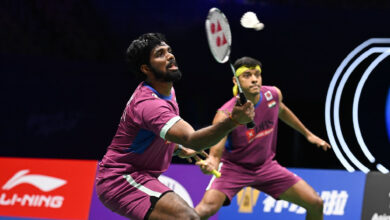Washington Sundar’s 7/59 had a magical ball and followed ‘God’s plan’

LAST WEEK, when India slid to a shock defeat in the first Test against New Zealand in Bengaluru, all-rounder Washington Sundar was playing a Ranji Trophy game for Tamil Nadu in Delhi. He scored a hundred there and suddenly things began to stir in his life. Not only did he get a call from the national selectors for the second Test, but he also leapfrogged frontline spinner Kuldeep Yadav to make it to the playing XI for the game.And on Day 1 of the Test, when New Zealand were coasting at 197/3, with the celebrated pairing of Ravichandran Ashwin and Ravindra Jadeja unable to get past the bat of the last game’s “player of the match” Rachin Ravindra, off-spinner Washington imposed himself on the game. More known for his batting in his short career of five Tests — averaging close to 50, he had made a stellar contribution with the bat in the famous Gabba win of 2021 — the 25-year-old proved to be India’s secret weapon with the ball. His 7/59 helped India bounce back in the three-Test series; they are trailing 0-1. With the senior off-spinner in the side, Ashwin taking 3/64, the two Chennai boys accounted for all 10 Kiwi wickets.
“It was God’s plan,” Washington said about the turn of events in his favour, from the anonymity of domestic cricket to potentially a series-saving spell. And it was a heavenly ball that got rid of Rachin and shot out New Zealand for 259. In reply, India were 16/1 at stumps.
He forked out a ball designed in a spin laboratory to castle Rachin. The ball drifted in but the movement was subtle. It didn’t move too much for Rachin’s long levers to smother the spin or too less for him to block. It dropped, a couple of centimetres shorter than the batsman expected, and spun across the bat-face. Rachin thought he had covered the line, but he hadn’t.
The turn was minimal, it just shaped rather than spat away. Had the ball turned more lavishly, it would have evaded the off-stump. Washington crouched and shrieked in delight before his teammates huddled around him. The dream ball would begin a dream day for him. He snaffled six more, in one of the greatest spells an Indian spinner at home.
Through the day, the cricketer with an unusual name was trending on social media. There is an interesting backstory to the name. It is a tale that stems from the gratitude of his father. Washington is named after P D Washington, an ex-Army man who used to be a godfather of sorts for his father, Sundar, helping him buy cricket gear during his playing days. He died just before the birth of the India all-rounder. In gratitude, Sundar named his son after the man.
Washington had to wait for his hour of glory. Between overs in the second session, the unassuming all-rounder tried to draw Rohit Sharma’s attention, doing warm-up routines in front of the captain, running and whispering in his ear, and appealing for nothing.
His first 13 overs were fruitless — the wicket column refused to reflect his perspiration. Then, when he was brushing his studs, removing the clipped grass, at the fag end of the session, he heard Rohit’s call. He smiled and waited for Jadeja to finish his over. Then he strolled in, waiting at the top of his run-up even before Rachin had realigned his guard. The New Zealand batsman made him wait, tying his shoelaces and scanning the field. The next ball, Washington’s wait ended with that dreamy delivery. “It was a dream ball… it means a lot. It was magical for sure,” he would say later.
The Rachin wicket was just the start. On both sides of the tea break, he ejected Tom Blundell and Daryll Mitchell. As his day got brighter than the Pune sun, Washington displayed the sharper layers of his bowling, stemming from acute self-awareness. He knows he is no Ashwin, with a large spread of variations in his tool box. He doesn’t possess a carrom ball; neither is he a prodigious turner of the ball. Once in a while, he slips in the under-cutter that fizzes along with the angle, like the one that burst through Tim Southee’s defence.
But he purchases bounce from the surface, aided his height, higher release point and the over-spin he imparts. His point of impact was thus higher than both his spin peers. Resultantly, the ball often hit the higher part of the bat. He comes across as one-dimensional, but is not. He shrewdly modulates his pace, not a wild fluctuation, but gentle switches. Depending on the batsman’s height and reach, he adapts his lengths. The deviations were minuscule. But that often suffices. He is like a taller, right-handed version of Jadeja.
In the span of 10 overs, he has passed the hierarchy, going past Kuldeep Yadav and Axar Patel. He is a comfortably better batsman than both, and illustrated on Thursday that he is not a tie-an-end-up workhorse. It was the day he came of age, from a diligent sidekick to the lead act.







